The Arcati Mainframe survey is one of the few out there (perhaps the only one?) that is vendor-neutral; that is, not commissioned by a major mainframe vendor, or a major “mainframe replacement” vendor. This fact alone illustrates the value of this survey, which have been running annually since 2005—for 20 years! This year’s survey results were included in the 2024 Arcati Yearbook. There were 10 particularly interesting results from the survey.
#1 90% of shops are using analytics but everyone is using it differently
Analytics is a growing activity in the mainframe datacenter—now almost 90% of the survey participants are reporting their use. However, these groups are very divided in how they use their analytics. Of the four defined options our survey offered, there was only a 9% spread from the most selected to the least. The underwhelming majority, 26%, specified they are using analytics to identify application resource consumption.
We expect the field of platform IT analytics to continue to grow in importance and will keep a close eye on how companies use and implement these—hoping that we do end up with apples-to-apples comparisons across organizations.

#2 Cloud usage is on the rise and even the largest mainframe users are predominantly hiring cloud talent
The survey participants have indicated a sharp increase in the utilization of Cloud services. This year, a whopping 70% of the participants in the know reported that their companies were leveraging AWS in some way. That’s double from only one year ago. The other major players (Google, Microsoft) are showing the same trends. Also notable is the decline of organizations reporting no public cloud usage—down 20% year over year.
Top Public Cloud Providers
- AWS
- Azure
When correlating the hiring trends of the participant’s companies, which shows increasing hiring rates for cloud and distributed systems, these numbers make sense. IT organizations are buying in to the Cloud completely—in a large part—to complement their mainframe systems. They are choosing platforms based on capability, workload appropriateness and cost.
We know that the demand for traditional mainframe roles is decreasing. For years, mainframe shops have sought to tackle the talent shortfall by creating a mainframe environment that requires fewer and fewer traditional mainframe skills. This, in addition to the increasing number of mainframe applications are front ended by non-mainframe applications on site in the datacenter, in the Cloud, or by mobile apps, means that we may be seeing slightly less demand for mainframe employment and mainframe staff are being asked to do more with less.
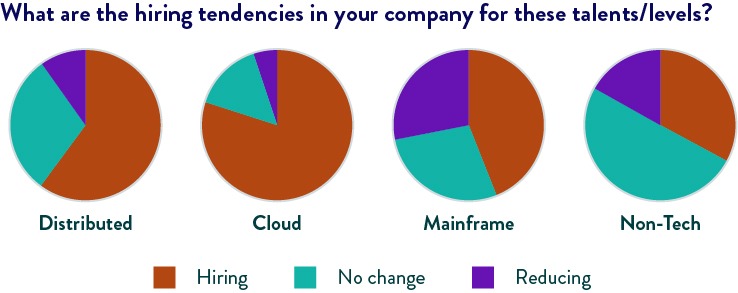
#3 Sixty-Four Percent of Companies Rely on Mainframe for their Business Revenue
Saying that your company’s business revenue is handled by the mainframe essentially means that the mainframe computer system is responsible for managing and processing all the critical financial transactions and operations that contribute to the company’s revenue. In many organizations, especially those that handle large volumes of transactions like banks (23% of respondents), insurance companies (15%), and large retailers (3.5%), mainframe systems are crucial. Among those respondents who reported the mainframe is used for their company’s business revenue, 19% reported more than 75% reliance and an additional 45% reported more than 50% reliance.
In all datacenters—even mainframe datacenters—you will find that most of the servers are distributed systems, or some combination of distributed servers and Cloud servers. This is true for almost any mainframe datacenter as well. So, if the ratio of mainframe boxes to non-mainframe boxes in a given datacenter is 1:50, 1:100 or 1:1000, why is most of the business revenue handled by the mainframe? Most people familiar with mainframe datacenters will tell you that it’s because the mainframe is high-security, high-reliability, high-performance, and highly cost-effective, and therefore is the best platform for handling a company’s business revenue.
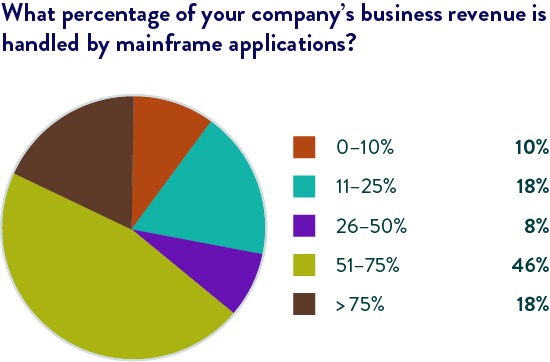
#4 The mainframe is still the preferred home for enterprise data.
The survey revealed a fascinating insight: in most mainframe datacenters, the mainframe isn’t just a relic of the past; it’s a vault holding the lion’s share of enterprise data. This is especially significant given the fact that virtually all companies are leveraging the Cloud at a growing rate year-by-year. For 56% of respondents their most important data remains on the mainframe. While we see trends of lower priority workloads and certain types of data being off-loaded, high-priority workloads (transaction processing, etc.) and business-critical enterprise data stay on the mainframe. In fact, of those respondents utilizing the mainframe at all for enterprise data, nearly two-thirds use it as their primary storage.
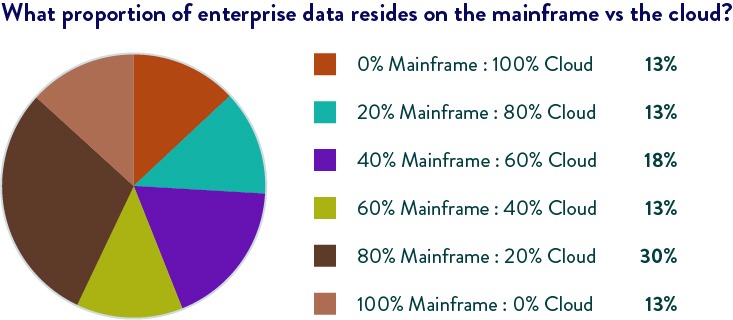
#5 For the largest users, MIPS usage keeps growing.
Every year the survey includes information about the MIPS usage in the survey participant’s mainframe datacenters. Back when this survey started in 2008, the largest group indicated 10,000 MIPS in their mainframe datacenters. Since then, trends like Modernization, Migration to the Cloud, Hardware and Software Upgrades, as well as other optimization techniques, have been expected to have an impact on the size of our systems.
However, this year the largest group indicated that their datacenters are consuming at least 25,000 mainframe MIPS – proving that the one thing that remains constant in the mainframe datacenter is increased resource usage, year-over-year. And that is truly great news.
Fifty-seven percent of shops are using more than 10,001 MIPS a gain of 21% over last year’s data. Concurrently, the shops using 10,000 or fewer MIPS is declining (33% compared to 64%). This data may indicate that while smaller shops are reducing their Mainframe workload, larger shops are leaning in and growing on the mainframe. Of the larger MIPS users (>10,001) more than 40% are projecting growth exceeding 10% annually.

#6 Mainframe usage doesn’t always equate to mainframe expenditure.
The majority of business revenue being handled by the mainframe is a very significant metric, considering that most survey participants indicated that there is more IT budget allocated to non-mainframe platforms than there is to the mainframe. Think about that – the platform responsible for most of the revenue for a company consumes less of the IT budget than the company’s other platforms (distributed computing, Cloud, etc.).
Today’s modern mainframe may delivery a superior value compared to alternative technologies. It was, after all, uniquely designed from the ground up to handle large-scale transaction processing efficiently. Other platforms are for the most part general-purpose low-cost commodity servers; even high-end servers with ultra-fast CPUs are general-purpose machines and cannot compete with the mainframe in areas of mainframe specialization. Serious study has shown that the mainframe is the most cost-effective platform for large businesses, as this article points out.
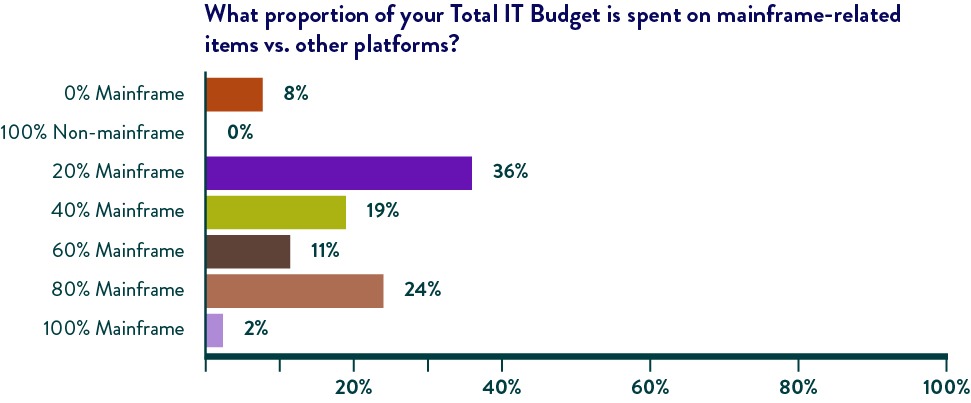
#7 For mainframe workloads, it’s a two-way street.
Workload migrations have been a fact of life for decades, for those people working within the mainframe silo. Over time, there are undoubtedly good reasons for migrations – for example, using Cloud resources for email management, rather than mainframe MSU resources. This is an ongoing process, and it makes sense in many instances. With a staggering 68% of companies moving workloads off the mainframe, it stands to reason that at least some of them are conducting large-scale migrations. However, often workload migrations off the mainframe can lead to unexpected costs, delays, and technical challenges.
This year’s survey indicated that there were a small number of workload migrations TO the mainframe – this would almost certainly imply that there were some failed workload migrations that needed to be moved back to the mainframe. Many survey participants also indicated that there were workload migrations in both directions. These results seem to add further credence to the commonly held view that platform selection and use is wholly dependent on the application. Put another way, all workloads are not created equal and each will have its own best platform.
While a majority (68%) of our respondents report that workloads are moving off the mainframe, a sizable minority (31%) reported that it’s a two-way street and that workloads are moving in both directions or back to the mainframe.
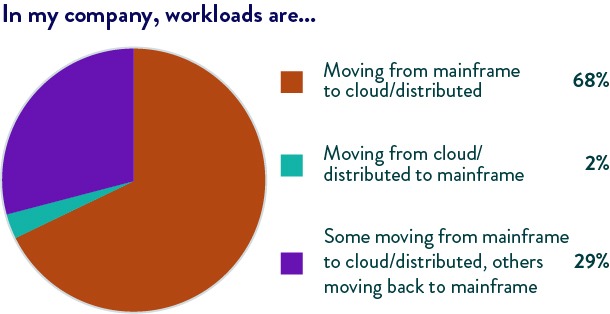
#8 Outsourcing is not as prevalent as you think.
Outsourcing is the worst-kept secret in the mainframe world. With IBM and a few large mainframe ISVs providing outsourcing services for many years, recent years have seen newcomers arriving on the scene for some of that action. And the result is that indeed, outsourcing options have sky-rocketed for mainframe datacenters, including many off-shore options. Further to that, the Big Four professional services networks are offering mainframe outsourcing services, and newer professional services firms located in North America, Europe, India, China and other off-shore locations, are now in the game. It goes to reason that a steadily growing number of mainframe datacenters are using these services. Interestingly, the majority of our respondents (70%) indicated that most were still managing things in-house. This is a decline of 4% since 2024—but data shows that most shops are only partially outsourcing their mainframe management. On the other hand, more than a quarter of them indicated that they were using outsourcing services to some degree. Given many of the results and trends contained in this survey, we can only expect that this trend towards outsourcing will continue to grow.
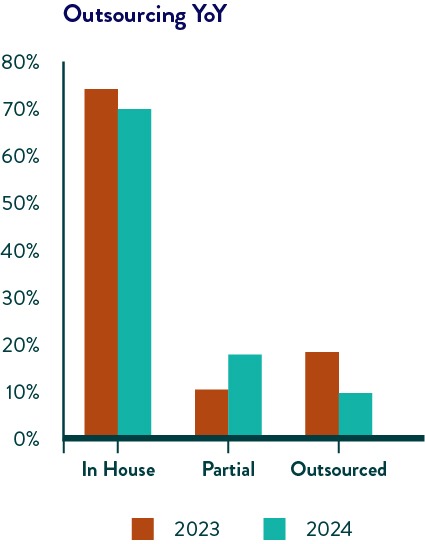
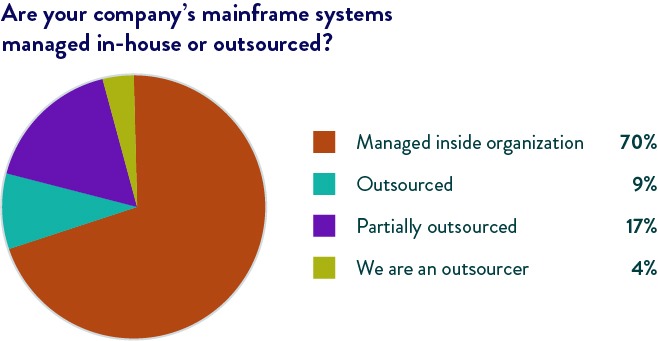
#9 Legacy Applications are not going anywhere and Application Modernization continues to be Priority #1
The last several iterations of the Arcati Mainframe survey have queried participants about their company’s top IT priorities for the coming year. Year-over-year we have tracked the rise of Application Modernization on everyone’s priorities list and this year, 58% indicated it was a top priority compared to 30% in 2023, and 12% in 2022. This aligns with the overwhelming majority (58%) of respondents that indicated that their strategy for legacy applications over the next three years will be to Maintain and Actively Integrate Legacy applications. Another 29% said that they would be using other apps to enhance their legacy applications. We predicted this with previous data that indicated that a whopping 81% percent of sites said that they were using APIs to connect to legacy applications to create new applications faster.
Top Three Priorities
- Systems or application modernization (56.25%)
- General IT security (47.92%)
- Cost optimization of mainframe (43.75)
As a runner up, IT security is front-and-center in all IT departments everywhere, regardless of whether they are mainframe datacenters, strictly distributed system datacenters or companies that outsource all of their IT to the Cloud. In fact, security concerns impact practically every department in a company, from IT, to Admin, to HR, to Finance, and all the way up to the C-suite. So, it was no surprise that it came second in the survey participants’ top-three priorities for 2024. Based on the general visibility of security concerns, one wonders how it could not finish in the top spot. Perhaps this reflects just how important modernization is for companies running mainframe datacenters.
#10 AI is top of Mind
We couldn’t produce a survey in 2024 without asking our audience about their plans for AI and Machine Learning. Approximately 25% of participants reported that they are either developing or have already deployed an AI/machine learning model on their mainframes. Additionally, 39% indicated that AI/machine learning is currently a subject of discussion within their organizations. We plan to monitor this trend closely in the coming years to observe how AI and Machine Learning models increasingly influence the industry.
In Conclusion
This year’s Arcati Mainframe Survey was a long one—a data-rich gold mine for information on what’s going on in today’s mainframe datacenters. The survey participants were IT professionals ranging from mainframe developers and DBAs to managers and IT executives – a very nicely focused group with inside datacenter knowledge. We’ve only just touched on the survey results with what we thought were the Top 10 highlights. There is much more information available in the survey as a whole – see the complete survey results in the 2024 Arcati Yearbook.









You reference a 2021 article in both #4 and #6 which made claims about the cost of mainframe workloads based upon a 2016 study I did for Mainframe Executive. I would like to set the record straight that the study I performed was specifically comparing zLinux workloads to distributed on-premise workloads. I made no claims for comparing z/OS workloads to distributed workloads or any mainframe workloads to the cloud.
Mike,
Thank you for highlighting the nuances of your 2016 study for Mainframe Executive. It’s essential we accurately represent such detailed comparisons, particularly between zLinux and distributed on-premise workloads, without misapplying conclusions to z/OS or cloud contexts. I have reached out to the author of the 2021 article to rectify the situation.
I know your expertise could greatly benefit our readers and we’d be honored if you could share more insights. Perhaps you’d consider writing an article for us? This could be a fantastic opportunity to delve deeper into the complexities of mainframe workloads and offer our audience a clearer understanding directly from the source.
We apologize for any oversight and eagerly anticipate the possibility of collaborating with you to enrich our content.
Best,
Amanda Hendley, Managing Editor
Mike,
I’ve spent the last few days reviewing both articles and discussing the nuances with a colleague. The 2021 article characterizes the mainframe as a “powerful and cost-effective computing platform for businesses,” a perspective that aligns well with the data points you presented in your 2016 article. Your main worry seems to be about readers possibly getting the wrong idea that your research compared these costs of mainframe with zOS, but honestly, I didn’t see any confusion there. It seems that Allan was careful to emphasize that your research was based on Linux and there is little- or no – mention of zOS anywhere. Would you agree?
Thank you for creating a conversation here. Here’s to more lively and enlightening discussions down the road!
Best,
Amanda
ahendley [at] planet mainframe . com
Amanda, Great Article! I wonder how many mainframe managers are worried about their ability to hire new talent and would like to see some statistics on their hiring practices in recent years for Z system programmers and Z DBAs. I spent most of my career supporting z/OS, Z/VM and Z/Linux, but would not encourage my children to do so as a carreer because there are so many other distributed tecnnology options to choose from, and the mainframe has taken a back seat as far as new workloads and budget in most of the banking and insurance clients I worked with lately. Mainframe support personnel must be very intelligent to do the work so how can they be expected to choose the mainframe as a carreer path when it is a dead end politically in most companies?